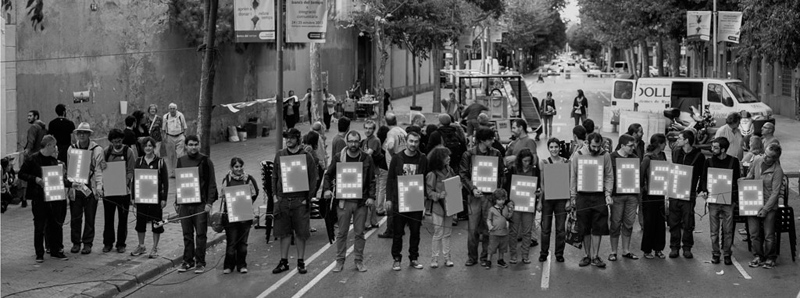Photographs as Public Space
DOI:
https://doi.org/10.1344/regac2015.1.09Keywords:
photography, photographs, ontology of photography, public spaceAbstract
Although the taking of a photograph –the moment of capture– has long been considered the essence of photography, the interest in archives over the past few decades has favoured a new conception of photography as a relational platform rather than the expression of the intentions of a single participant. Similarly, although there is greater awareness of the fact that photographs are an integral part of a system that regulates their authority and governs the ideological dictates that legitimise the way images are shown, disseminated, concealed or destroyed, there is nonetheless an urgent need to define new parameters for interpreting the encounter that photography sets in motion. Based on the new ontology of photography developed by Ariella Azoulay, in which she argues that photography should be understood as a collective event, this text has a twofold objective: to show how Azoulay’s approach is a radically necessary contribution to activating a freer and more active imaginary, and to determine how photography, by overcoming the logic of representation and the axiom of the fait accompli, can be constituted as public space.References
Azoulay, A. (2009). Al·legacions d’emergència: tres arguments sobre l’ontologia de la fotografia, en P. Vicente (ed.), Instantànies de la fotografia. Tarragona: Arola Editors, 87-97.
Azoulay, A. (2010). What is a photograph? What is photography? Philosophy of Photography, 1(1), 9-13.
Azoulay, A. (2012). Civil Imagination. A Political Ontology of Photography. Nueva York: Verso.
Azoulay, A. (2012). L’Obligation de parler des photographies non prises, en D. Zabunyan (ed.), Les Images manquantes. París: Images et Manœuvres, 115-137.
Azoulay, A. (2008). The Civil Contract of Photography. Nueva York: Zone Books.
Barthes, R. (1989). La cámara lúcida. Barcelona: Paidós.
Batchen, G. (2004). Arder en deseos: La concepción de la fotografía. Barcelona: Gustavo Gili.
Butler, J. (2005). Torture and the Ethics of Photography. Environment and Planning D: Society and Space, 25, 951-966.
Campany, D. (2013). Still Searching. An Online Discourse on Photography. Blog Fotomuseum Winterthur (http://blog.fotomuseum.ch/2013/04/1- photography-and-photographs/).
Dahó, M. (2009). En la línea de sombra, en Graciela Iturbide, cat. exp. Madrid: Fundación Mapfre.
Dahó, M. (2013). Leve, rápida, exacta, visible y múltiple. ¿Nuevos valores de la imagen fotográfica? en N. Canclini García y J. Villoro (eds.), La creatividad redistribuida. México D.F.: Siglo XXI.
Fontcuberta, J. (ed.) (2008). ¿Soñarán los androides con cámaras fotográficas? Encuentros PHE08. Madrid: La Fábrica.
Green, D. (ed.) (2007). ¿Qué ha sido de la fotografía? Barcelona: Gustavo Gili.
Guerra, C. (2014). El despliegue del dispositivo documental, en Nitrato. Barcelona: Macba.
Gunthert, A. (2010). Les Androïdes rêvent-ils de photos de famille? L’Atelier des icones, 4 de enero de 2010 (http://culturevisuelle.org/icones/338).
Iturbide, G. (2003). Graciela Iturbide habla con Fabienne Bradu. Madrid: La Fábrica.
Keenan, T. & Steyerl, H. (2014). What is a document? An Exchange between Thomas Keenan and Hito Steyerl. Aperture Magazine, 214, 58-64.
Keenan, T. & Weizman, E. (2012). Mengele’s Skull: The Advent of Forensic Aesthetics. Berlín: Sternberg and Portikus.
Lavoie, V. (1996). Les Fins de l’ontologie photographique. CV Photo, 36, 5-6.
Medina, C. (2001). Graciela Iturbide. Londres: Phaidon.
Osborne, P. (2010). Infinite exchange: The social ontology of the photographic image. Philosophy of Photography, vol. 1, núm. 1, pp. 59-68.
Phillips, C. (1997). El tribunal de la fotografía, en J. Ribalta, y G. Picazo (eds.), Indiferencia y singularidad. La fotografía en el pensamiento artístico contemporáneo. Barcelona: Macba.
Publicado originalmente en Bolton, R. (ed.) (1989). The Contest of Meaning. Critical Histories of Photography. Cambridge: MITT Press.
Ribas, X. (2014). Nitrato. Barcelona: Macba.
Rosler, M. (2004). Dentro, alrededor y otras reflexiones. Sobre la fotografía documental, en J. Ribalta (ed.), Efecto real. Debates posmodernos sobre fotografía. Barcelona: Gustavo Gili.
Sontag, S. (1981). Sobre la fotografía. Barcelona: Edhasa.
Sontag, S. (2004). Ante el dolor de los demás. Madrid: Santillana.
Stahel, U. (2003). Well, What is Photography? Zurich: Scalo.
VV.AA. (2010). Is Photography Over?, simposium, SFMoma, abril 2010 (www.sfmoma.org/isphotographyover).
VV.AA. (2015). Images à charge. La Construction de la preuve par l’image. París: Xavier Barral.
Willumeit, L. (2015). Beyond Evidence: An Incomplete Narratology of Photographic Truth. Derby: Quad/Format.
Downloads
Published
Issue
Section
License
Authors who publish with this journal agree to the following terms:
- Authors retain copyright and grant the journal right of first publication with the work simultaneously licensed under a Creative Commons Attribution Licensethat allows others to share the work with an acknowledgement of the work's authorship and initial publication in this journal.
- Authors are able to enter into separate, additional contractual arrangements for the non-exclusive distribution of the journal's published version of the work (e.g., post it to an institutional repository or publish it in a book), with an acknowledgement of its initial publication in this journal.
- Authors are permitted and encouraged to post their work online (e.g., in institutional repositories or on their website) prior to and during the submission process, as it can lead to productive exchanges, as well as earlier and greater citation of published work (See The Effect of Open Access).



